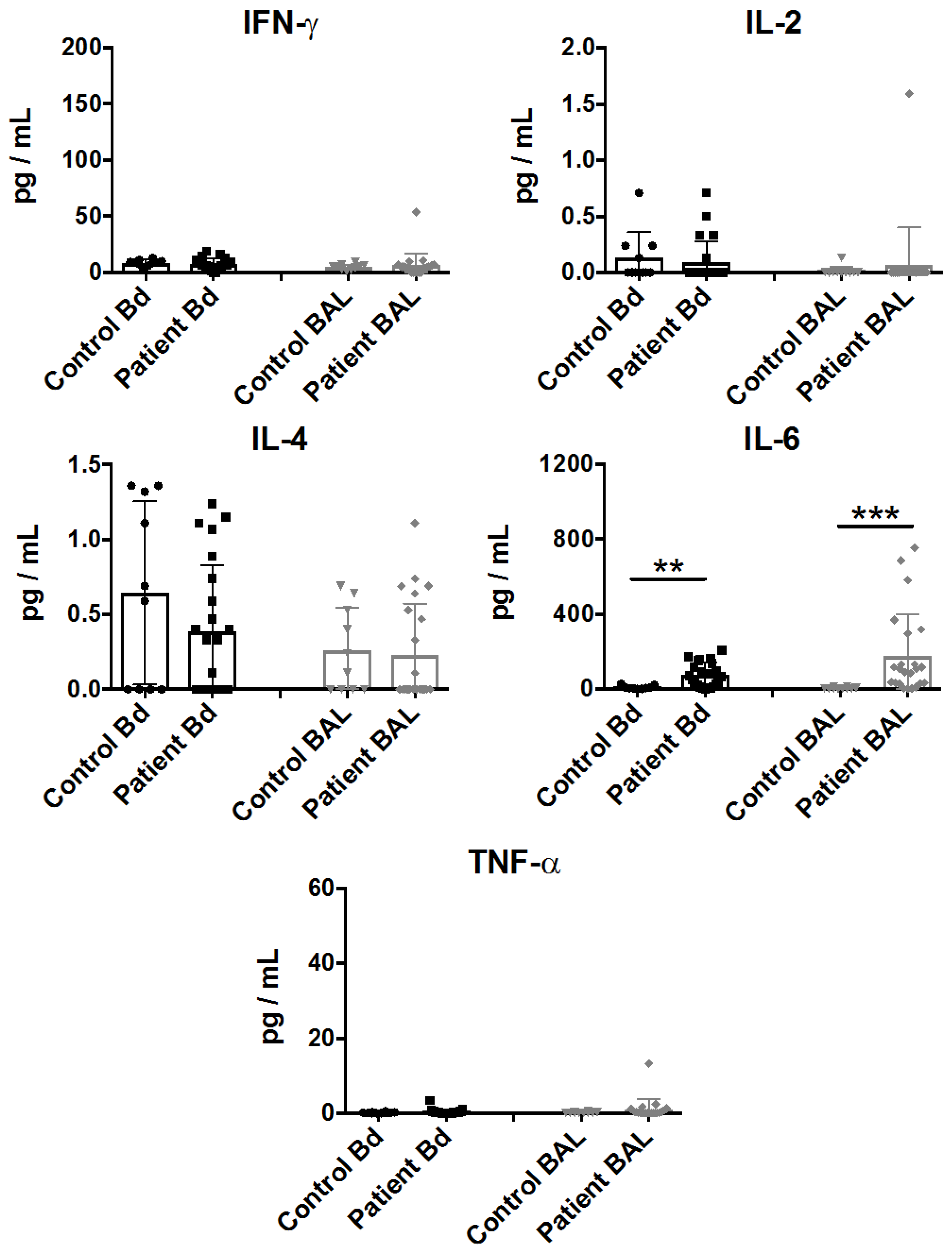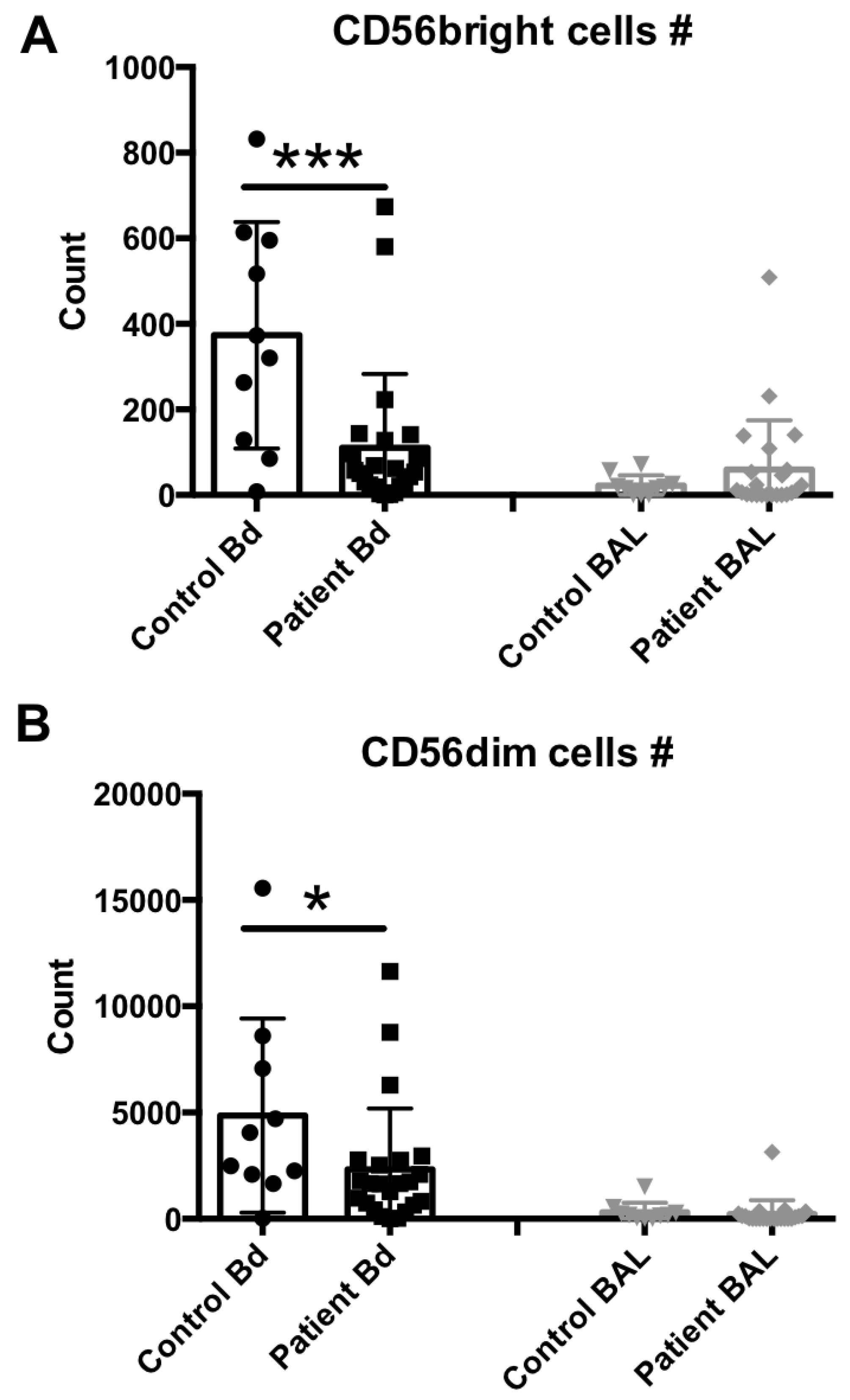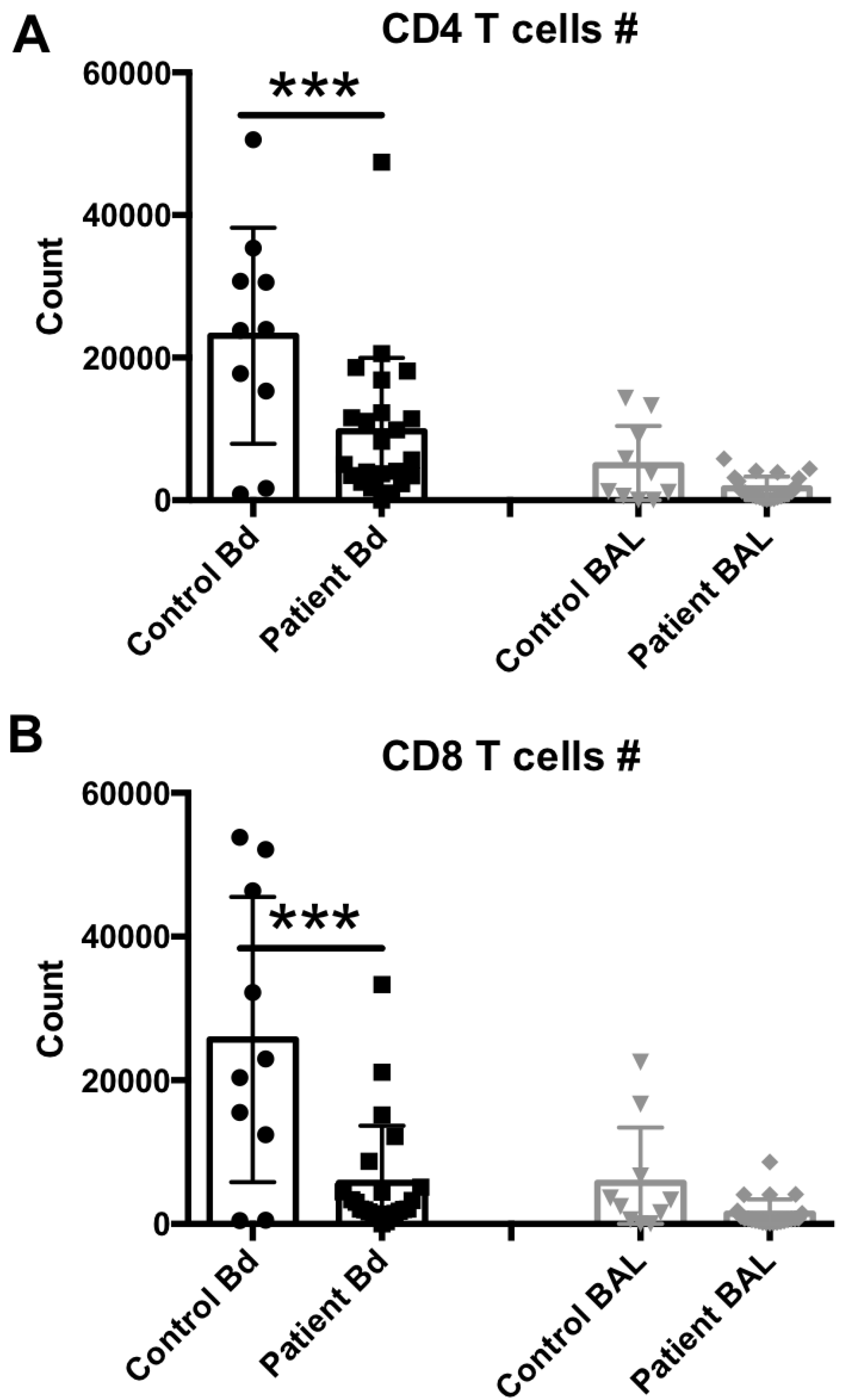Natural Killer Cell Assessment in Peripheral Circulation and Bronchoalveolar Lavage Fluid of Patients with Severe Sepsis: A Case Control Study
Abstract
:1. Introduction
2. Results
2.1. Patients Characteristics
2.2. Pro-Inflammatory Cytokine Profiling in Bronchoalveolar Lavage (BAL) Fluid Samples after Sepsis
2.3. Natural Killer (NK) Cell Subsets Are Reduced in Peripheral Blood but Unchanged in BAL Fluid Samples after Sepsis
2.4. T CD4 and T CD8 Cell Levels Are Also Reduced in the Peripheral Blood, but Not in the BAL Fluid of Sepsis Patients
3. Discussion
4. Experimental Section
4.1. Clinical Samples
4.2. Reagents
4.3. Flow Cytometry
4.4. Statistical Analysis
Supplementary Materials
Acknowledgments
Author Contributions
Conflicts of Interest
References
- Seymour, C.W.; Liu, V.X.; Iwashyna, T.J.; Brunkhorst, F.M.; Rea, T.D.; Scherag, A.; Rubenfeld, G.; Kahn, J.M.; Shankar-Hari, M.; Singer, M.; et al. Assessment of clinical criteria for sepsis: For the third international consensus definitions for sepsis and septic shock (Sepsis-3). JAMA 2016, 315, 762–774. [Google Scholar] [CrossRef] [PubMed]
- Shankar-Hari, M.; Phillips, G.S.; Levy, M.L.; Seymour, C.W.; Liu, V.X.; Deutschman, C.S.; Angus, D.C.; Rubenfeld, G.D.; Singer, M.; Sepsis Definitions Task, F. Developing a new definition and assessing new clinical criteria for septic shock: For the third international consensus definitions for sepsis and septic shock (Sepsis-3). JAMA 2016, 315, 775–787. [Google Scholar] [CrossRef] [PubMed]
- Angus, D.C.; Linde-Zwirble, W.T.; Lidicker, J.; Clermont, G.; Carcillo, J.; Pinsky, M.R. Epidemiology of severe sepsis in the united states: Analysis of incidence, outcome, and associated costs of care. Crit. Care Med. 2001, 29, 1303–1310. [Google Scholar] [CrossRef] [PubMed]
- Schulte, W.; Bernhagen, J.; Bucala, R. Cytokines in sepsis: Potent immunoregulators and potential therapeutic targets—An updated view. Mediat. Inflamm. 2013, 2013, 165974. [Google Scholar] [CrossRef] [PubMed]
- Bone, R.C.; Sibbald, W.J.; Sprung, C.L. The ACCP-SCCM consensus conference on sepsis and organ failure. Chest 1992, 101, 1481–1483. [Google Scholar] [CrossRef] [PubMed]
- Annane, D.; Bellissant, E.; Cavaillon, J.M. Septic shock. Lancet 2005, 365, 63–78. [Google Scholar] [CrossRef]
- Cohen, J. The immunopathogenesis of sepsis. Nature 2002, 420, 885–891. [Google Scholar] [CrossRef] [PubMed]
- Souza-Fonseca-Guimaraes, F.; Cavaillon, J.M.; Adib-Conquy, M. Bench-to-bedside review: Natural killer cells in sepsis—Guilty or not guilty? Crit. Care 2013, 17, 235. [Google Scholar] [CrossRef] [PubMed]
- Rasid, O.; Cavaillon, J.M. Recent developments in severe sepsis research: From bench to bedside and back. Future Microbiol. 2016, 11, 293–314. [Google Scholar] [CrossRef] [PubMed]
- Bone, R.C. Sir isaac newton, sepsis, SIRS, and CARS. Crit. Care Med. 1996, 24, 1125–1128. [Google Scholar] [CrossRef] [PubMed]
- Parlato, M.; Cavaillon, J.M. Host response biomarkers in the diagnosis of sepsis: A general overview. Methods Mol. Biol. 2015, 1237, 149–211. [Google Scholar] [PubMed]
- Adib-Conquy, M.; Cavaillon, J.M. Compensatory anti-inflammatory response syndrome. Thromb. Haemost. 2009, 101, 36–47. [Google Scholar] [CrossRef] [PubMed]
- Cavaillon, J.M.; Adib-Conquy, M. Monocytes/macrophages and sepsis. Crit. Care Med. 2005, 33, S506–S509. [Google Scholar] [CrossRef] [PubMed]
- Adib-Conquy, M.; Scott-Algara, D.; Cavaillon, J.M.; Souza-Fonseca-Guimaraes, F. TLR-mediated activation of NK cells and their role in bacterial/viral immune responses in mammals. Immunol. Cell Biol. 2014, 92, 256–262. [Google Scholar] [CrossRef] [PubMed]
- Krasnova, Y.; Putz, E.M.; Smyth, M.J.; Souza-Fonseca-Guimaraes, F. Bench to bedside: NK cells and control of metastasis. Clin. Immunol. 2015. [Google Scholar] [CrossRef] [PubMed]
- Souza-Fonseca-Guimaraes, F. NK cell-based immunotherapies: Awakening the innate anti-cancer response. Discov. Med. 2016, 21, 197–203. [Google Scholar] [PubMed]
- Souza-Fonseca-Guimaraes, F.; Adib-Conquy, M.; Cavaillon, J.M. Natural killer (NK) cells in antibacterial innate immunity: Angels or devils? Mol. Med. 2012, 18, 270–285. [Google Scholar] [CrossRef] [PubMed]
- Souza-Fonseca-Guimaraes, F.; Parlato, M.; Fitting, C.; Cavaillon, J.M.; Adib-Conquy, M. NK cell tolerance to TLR agonists mediated by regulatory T cells after polymicrobial sepsis. J. Immunol. 2012, 188, 5850–5858. [Google Scholar] [CrossRef] [PubMed]
- Andaluz-Ojeda, D.; Iglesias, V.; Bobillo, F.; Almansa, R.; Rico, L.; Gandia, F.; Loma, A.M.; Nieto, C.; Diego, R.; Ramos, E.; et al. Early natural killer cell counts in blood predict mortality in severe sepsis. Crit. Care 2011, 15, R243. [Google Scholar] [CrossRef] [PubMed]
- Sathe, P.; Delconte, R.B.; Souza-Fonseca-Guimaraes, F.; Seillet, C.; Chopin, M.; Vandenberg, C.J.; Rankin, L.C.; Mielke, L.A.; Vikstrom, I.; Kolesnik, T.B.; et al. Innate immunodeficiency following genetic ablation of MCL1 in natural killer cells. Nat. Commun. 2014, 5, 4539. [Google Scholar] [CrossRef] [PubMed]
- Etogo, A.O.; Nunez, J.; Lin, C.Y.; Toliver-Kinsky, T.E.; Sherwood, E.R. NK but not CD1-restricted NKT cells facilitate systemic inflammation during polymicrobial intra-abdominal sepsis. J. Immunol. 2008, 180, 6334–6345. [Google Scholar] [CrossRef] [PubMed]
- Souza-Fonseca-Guimaraes, F.; Young, A.; Mittal, D.; Martinet, L.; Bruedigam, C.; Takeda, K.; Andoniou, C.E.; Degli-Esposti, M.A.; Hill, G.R.; Smyth, M.J. NK cells require IL-28R for optimal in vivo activity. Proc. Natl. Acad. Sci. USA 2015, 112, E2376–E2384. [Google Scholar] [CrossRef] [PubMed]
- De Jong, H.K.; van der Poll, T.; Wiersinga, W.J. The systemic pro-inflammatory response in sepsis. J. Innate Immun. 2010, 2, 422–430. [Google Scholar] [CrossRef] [PubMed]
- Mera, S.; Tatulescu, D.; Cismaru, C.; Bondor, C.; Slavcovici, A.; Zanc, V.; Carstina, D.; Oltean, M. Multiplex cytokine profiling in patients with sepsis. APMIS 2011, 119, 155–163. [Google Scholar] [CrossRef] [PubMed]
- Venet, F.; Davin, F.; Guignant, C.; Larue, A.; Cazalis, M.A.; Darbon, R.; Allombert, C.; Mougin, B.; Malcus, C.; Poitevin-Later, F.; et al. Early assessment of leukocyte alterations at diagnosis of septic shock. Shock 2010, 34, 358–363. [Google Scholar] [CrossRef] [PubMed]
- Souza-Fonseca-Guimaraes, F.; Parlato, M.; Philippart, F.; Misset, B.; Cavaillon, J.M.; Adib-Conquy, M.; Captain Study Group. Toll-like receptors expression and interferon-gamma production by NK cells in human sepsis. Crit. Care 2012, 16, R206. [Google Scholar] [CrossRef] [PubMed]
- Ponting, G.A.; Sim, A.J.; Dudley, H.A. Comparison of the local and systemic effects of sepsis in predicting survival. Br. J. Surg. 1987, 74, 750–752. [Google Scholar] [CrossRef] [PubMed]
- Cavaillon, J.M.; Annane, D. Compartmentalization of the inflammatory response in sepsis and SIRS. J. Endotoxin Res. 2006, 12, 151–170. [Google Scholar] [CrossRef] [PubMed]
- Hotchkiss, R.S.; Tinsley, K.W.; Swanson, P.E.; Chang, K.C.; Cobb, J.P.; Buchman, T.G.; Korsmeyer, S.J.; Karl, I.E. Prevention of lymphocyte cell death in sepsis improves survival in mice. Proc. Natl. Acad. Sci. USA 1999, 96, 14541–14546. [Google Scholar] [CrossRef] [PubMed]
- Inoue, S.; Unsinger, J.; Davis, C.G.; Muenzer, J.T.; Ferguson, T.A.; Chang, K.; Osborne, D.F.; Clark, A.T.; Coopersmith, C.M.; McDunn, J.E.; et al. IL-15 prevents apoptosis, reverses innate and adaptive immune dysfunction, and improves survival in sepsis. J. Immunol. 2010, 184, 1401–1409. [Google Scholar] [CrossRef] [PubMed]
- Unsinger, J.; McGlynn, M.; Kasten, K.R.; Hoekzema, A.S.; Watanabe, E.; Muenzer, J.T.; McDonough, J.S.; Tschoep, J.; Ferguson, T.A.; McDunn, J.E.; et al. IL-7 promotes T cell viability, trafficking, and functionality and improves survival in sepsis. J. Immunol. 2010, 184, 3768–3779. [Google Scholar] [CrossRef] [PubMed]
- Drewry, A.M.; Samra, N.; Skrupky, L.P.; Fuller, B.M.; Compton, S.M.; Hotchkiss, R.S. Persistent lymphopenia after diagnosis of sepsis predicts mortality. Shock 2014, 42, 383–391. [Google Scholar] [CrossRef] [PubMed]
- Herzig, D.S.; Driver, B.R.; Fang, G.; Toliver-Kinsky, T.E.; Shute, E.N.; Sherwood, E.R. Regulation of lymphocyte trafficking by CXC chemokine receptor 3 during septic shock. Am. J. Respir. Crit. Care Med. 2012, 185, 291–300. [Google Scholar] [CrossRef] [PubMed]
- Oppenheimer-Marks, N.; Davis, L.S.; Lipsky, P.E. Human T lymphocyte adhesion to endothelial cells and transendothelial migration. Alteration of receptor use relates to the activation status of both the T cell and the endothelial cell. J. Immunol. 1990, 145, 140–148. [Google Scholar] [PubMed]
- Warren, H.S.; Fitting, C.; Hoff, E.; Adib-Conquy, M.; Beasley-Topliffe, L.; Tesini, B.; Liang, X.; Valentine, C.; Hellman, J.; Hayden, D.; et al. Resilience to bacterial infection: Difference between species could be due to proteins in serum. J. Infect. Dis. 2010, 201, 223–232. [Google Scholar] [CrossRef] [PubMed]
- Seok, J.; Warren, H.S.; Cuenca, A.G.; Mindrinos, M.N.; Baker, H.V.; Xu, W.; Richards, D.R.; McDonald-Smith, G.P.; Gao, H.; Hennessy, L.; et al. Genomic responses in mouse models poorly mimic human inflammatory diseases. Proc. Natl. Acad. Sci. USA 2013, 110, 3507–3512. [Google Scholar] [CrossRef] [PubMed]
- Girardot, T.; Rimmele, T.; Venet, F.; Monneret, G. Apoptosis-induced lymphopenia in sepsis and other severe injuries. Apoptosis 2016, 22, 295–305. [Google Scholar] [CrossRef] [PubMed]
- Goldstein, R.A.; Rohatgi, P.K.; Bergofsky, E.H.; Block, E.R.; Daniele, R.P.; Dantzker, D.R.; Davis, G.S.; Hunninghake, G.W.; King, T.E., Jr.; Metzger, W.J.; et al. Clinical role of bronchoalveolar lavage in adults with pulmonary disease. Am. Rev. Respir. Dis. 1990, 142, 481–486. [Google Scholar] [PubMed]
- Meyer, K.C.; Raghu, G.; Baughman, R.P.; Brown, K.K.; Costabel, U.; du Bois, R.M.; Drent, M.; Haslam, P.L.; Kim, D.S.; Nagai, S.; et al. An official American thoracic society clinical practice guideline: The clinical utility of bronchoalveolar lavage cellular analysis in interstitial lung disease. Am. J. Respir. Crit. Care Med. 2012, 185, 1004–1014. [Google Scholar] [CrossRef] [PubMed]



| Parameter | Controls (n = 10) | Sepsis (n = 23) |
|---|---|---|
| Age mean (SD) | 49.4 (22.6) | 59.17 (17.02) |
| Gender, n (%) | ||
| Male | 8 (80%) | 16 (69.57%) |
| Female | 2 (20%) | 7 (30.43%) |
| Body mass index, kg/m2, mean (SD) | 28.13 (2.48) | 26.14 (4.61) |
| Comorbidity, n (%) | 14 (60.86%) | |
| Hemorrhagic cerebrovascular accident | N/A | 4 (17.39%) |
| Other cerebrovascular accident (ischemia, or aneurysm) | 4 (40%) | 3 (13.04%) |
| COPD | N/A | 1 (4.35%) |
| Cancer | N/A | 1 (4.35%) |
| Lung | N/A | 4 (17.39%) |
| Liver failure | N/A | 1 (4.35%) |
| Skull/spine fracture | N/A | 4 (17.39%) |
| Polytrauma | 6 (60%) | 4 (17.39%) |
| Mechanic ventilation | N/A | 23 (100%) |
| Infection site | ||
| Urinary tract | N/A | 10 (43.48%) |
| Tracheal aspirate | N/A | 19 (82.61%) |
| Mechanic ventilation | N/A | 23 (100%) |
| Leukocytes, %/mm3, mean (SD) | N/A | 15,059.56 (10424.43) |
| SOFA, mean (SD) | N/A | 5.43 (2.27) |
| SAPS II, mean (SD) | N/A | 21 (9.95) |
| Length of stay in hospital, days, means (SD) | N/A | 39.82 (21.21) |
| Length of stay in ICU, days, mean (SD) | N/A | 18.78 (9.96) |
| In-hospital mortality number (%) | N/A | 7 (30.43%) |
| Gram-positive bacteria (%) | N/A | 2 (8.69%) |
| Gram-negative bacteria (%) | N/A | 15 (65.21%) |
| Fungus | N/A | 3 (13.04%) |
| Undetermined microbial infection | N/A | 3 (13.04%) |
© 2017 by the authors. Licensee MDPI, Basel, Switzerland. This article is an open access article distributed under the terms and conditions of the Creative Commons Attribution (CC BY) license ( http://creativecommons.org/licenses/by/4.0/).
Share and Cite
Souza-Fonseca-Guimaraes, P.; Guimaraes, F.; Natânia De Souza-Araujo, C.; Maria Boldrini Leite, L.; Cristina Senegaglia, A.; Nishiyama, A.; Souza-Fonseca-Guimaraes, F. Natural Killer Cell Assessment in Peripheral Circulation and Bronchoalveolar Lavage Fluid of Patients with Severe Sepsis: A Case Control Study. Int. J. Mol. Sci. 2017, 18, 616. https://doi.org/10.3390/ijms18030616
Souza-Fonseca-Guimaraes P, Guimaraes F, Natânia De Souza-Araujo C, Maria Boldrini Leite L, Cristina Senegaglia A, Nishiyama A, Souza-Fonseca-Guimaraes F. Natural Killer Cell Assessment in Peripheral Circulation and Bronchoalveolar Lavage Fluid of Patients with Severe Sepsis: A Case Control Study. International Journal of Molecular Sciences. 2017; 18(3):616. https://doi.org/10.3390/ijms18030616
Chicago/Turabian StyleSouza-Fonseca-Guimaraes, Paulo, Fernando Guimaraes, Caroline Natânia De Souza-Araujo, Lidiane Maria Boldrini Leite, Alexandra Cristina Senegaglia, Anita Nishiyama, and Fernando Souza-Fonseca-Guimaraes. 2017. "Natural Killer Cell Assessment in Peripheral Circulation and Bronchoalveolar Lavage Fluid of Patients with Severe Sepsis: A Case Control Study" International Journal of Molecular Sciences 18, no. 3: 616. https://doi.org/10.3390/ijms18030616
APA StyleSouza-Fonseca-Guimaraes, P., Guimaraes, F., Natânia De Souza-Araujo, C., Maria Boldrini Leite, L., Cristina Senegaglia, A., Nishiyama, A., & Souza-Fonseca-Guimaraes, F. (2017). Natural Killer Cell Assessment in Peripheral Circulation and Bronchoalveolar Lavage Fluid of Patients with Severe Sepsis: A Case Control Study. International Journal of Molecular Sciences, 18(3), 616. https://doi.org/10.3390/ijms18030616







